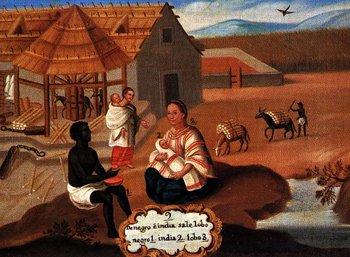Zambo
|
|

Zambo (cafuzo in Brazil, lobo in Mexico, Garifuna in Honduras and Belize) is a term of Latin American origin describing peoples of mixed African and Amerindian racial descent. The feminine form is zamba (not to be confused with the afro-Brazilian Samba folk dance or Samba music, or with Argentine zamba folk dance). A more modern, related term, which is growing in acceptance, is "Afro-Latinos," which refers to any Latino of African ancestry, including those who have Amerindian and European progenitors.
Zambo also may be used, though very rarely, to denote the offspring resulting from the union of a mulatto and an African.
The first zambos were initially the offspring of escaping shipwrecked slaves, as well as plantation slave escapees, who ventured into various Central American, South American and Caribbean jungles seeking refuge in remote Amerindian communities to hide and escape capture by colonial authorities. These Amerindians — themselves under threat from encroaching European colonizers — were sympathetic to the plight of the fleeing slaves and welcomed them into their communities, offered them food and sanctuary, and in many cases also their daughters as wives. As in the United States during slavery, there are instances in Latin American history of Africans and Amerindians joining together and forming free renegade encampments to fight their European colonizers and slaveholders. In Latin America, these primarily African settlements of runaways, or Maroons, were called quilombos. The most famous of all quilombos is the legendary Palmares in Brazil, which at the height of its flourishing had a population of over 30,000.
Afro-Latinos of African and Amerindian ancestry, or Zambos, are present in significant numbers throughout Central and South America; however, many do not identify themselves as such, or as "Zambos," preferring simply to call themselves "Latinos." The nations with the largest numbers of persons of mixed African and Amerindian descent tend to be coastal nations that were more directly affected by the trans-Atlantic slave trade, such as Brazil, Panama, Nicaragua, Venezuela, Costa Rica, Guatemala, etc.
Zambos represent small minorities in the northwestern South American countries of Colombia (3%), Venezuela and Ecuador, and along northwestern Brazil, where they are known as Cafuzos. In Honduras, they are known as Garifunas; and while Zambos can also be found in other Caribbean and Central America countries (notably Belize and Guatemala), their history and origins are not linked to that of the Garifuna. In Mexico, where they were known as Lobos, they formed a sizeable minority in the past. The great majority of Lobos have now been absorbed into the much larger mixed Mexican Mestizo population and can be found in only tiny communities scattered around the southern coastal states, most notably the state of Veracruz and the Costa Chica. Culturally, Mexican Lobos followed Amerindian traditions rather than African ones. This is also the case in Bolivia, where the Afro-Bolivian community has absorbed many aspects of Amerindian culture, such as dress and use of the Mymara language.
The history behind the African ancestry of the Garifuna is usually attributed to escaping shipwrecked slaves; whereas, the Zambos of northwestern South America, the Lobos of Mexico and most other Zambos are the descendants of former plantation slaves.
Zambos resulting from modern-day unions beteen Amerindians and blacks in major costal cities of Ecuador (ethnicities that prior to the rural to urban migration were mostly constrained to the Andes region and Esmeraldas province, respectively) are not uncommon.
